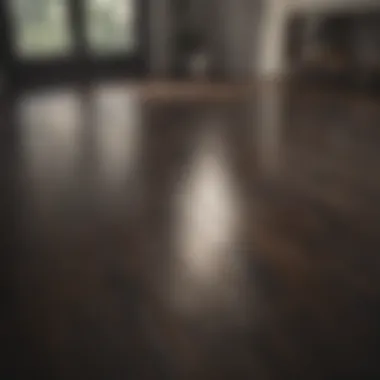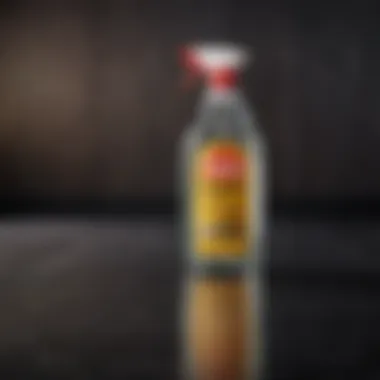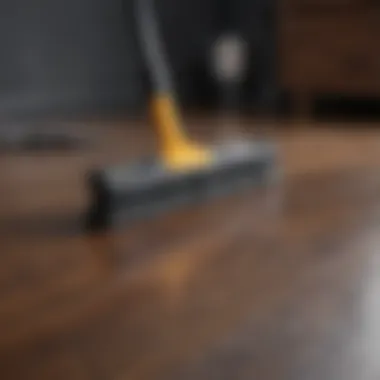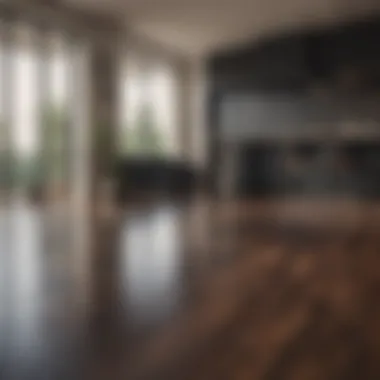Cleaning Dark Laminate Floors: A Guide to Streak-Free Shine


Intro
Cleaning dark laminate floors presents specific challenges not seen in lighter surfaces. Dark floors have a tendency to show dust, dirt, and streaks more readily, often resulting in a frustrating cleaning experience. Homeowners and cleaning enthusiasts who seek a streak-free shine must understand that the right techniques and products can vastly improve the outcome. This guide provides comprehensive tips and solutions tailored to achieve and maintain the beauty of these floors.
Home Features
When considering dark laminate flooring, it is essential to take note of the aesthetics it brings to a space. Dark laminate floors are often chosen for their ability to add elegance and sophistication to various home styles.
- Architectural Marvels
Such floors can transform ordinary rooms into remarkable spaces. In contemporary homes, dark laminate can create a striking contrast with light walls and furnishings. Additionally, its glossy finish can enhance the effect of designer lighting, providing depth and warmth to interiors. - Unique Design Elements
Incorporating dark laminate floors into your home allows for unique design opportunities. Consider pairing them with light-colored rugs or furniture to ensure balance. Adding warm tones through décor can also reduce the starkness while maintaining a chic appearance. Choosing accents that coordinate with dark surfaces is vital for achieving a cohesive look.
Cleaning Techniques
Cleaning dark laminate floors requires a strategic approach. Here are critical steps to ensure that your floors remain lustrous and streak-free:
- Sweep or Vacuum Regularly
Accumulated dust and dirt will cling to dark surfaces. Regular sweeping or vacuuming helps prevent buildup. - Use the Right Cleaning Solution
Choose a laminate-specific cleaner. Avoid harsh chemicals as they can damage the finish of the laminate. - Mopping with Care
When mopping, use a damp mop rather than a soaking wet one. Excess water can warp laminate. - Dry Thoroughly
After mopping, ensure the floor is dried completely. Use a microfiber cloth for best results.
"A regular cleaning schedule, combined with the correct products, guarantees that your dark laminate will look like new for years to come."
Maintenance Tips
Maintaining the pristine condition of dark laminate floors goes beyond cleaning.
- Avoid Scratches
Place felt pads under furniture legs to prevent scratches. - Use Rugs Strategically
Place rugs in high-traffic areas to protect the flooring. Ensure they complement the dark surface for cohesive design. - Control Humidity
Keep indoor humidity at moderate levels. Excess moisture can negatively affect laminate lifespan.
Culmination
Achieving a streak-free shine on dark laminate floors is an attainable goal with the right knowledge. It is crucial to understand both the demands of dark surfaces and the most effective cleaning techniques. By following the provided steps and incorporating maintenance tips, homeowners can enjoy lasting beauty and elegance from their laminate flooring.
Understanding Dark Laminate Floors
Understanding dark laminate floors is essential for proper maintenance and cleaning. These surfaces have unique attributes and require tailored care to enhance their appearance and durability. Dark laminate adds sophistication to any space yet has its challenges. Being aware of these factors is key to achieving the desired shine without streaks.
Characteristics of Dark Laminate
Dark laminate floors are designed to mimic the look of natural wood. They often feature rich colors that range from deep browns to blacks. This finish can make a room feel warm and inviting but can also highlight dirt and dust more than lighter surfaces. The finish on these floors can be glossy or matte, each reflecting light differently. Glossy finishes tend to show smudges and dust more prominently, while matte finishes can be more forgiving.
The construction of dark laminate includes several layers. Typically, it consists of a backing layer, a core layer for durability, and a photographic layer that simulates wood grain and color. The top layer usually features a protective coating that makes the floor scratch and stain resistant but not impervious.
Common Cleaning Challenges
Cleaning dark laminate floors comes with its own set of challenges. Dust and fingerprints tend to be more visible on dark surfaces. As a result, these floors may appear dirty quickly. This can lead to frequent cleanings to maintain aesthetic appeal. Additionally, improper cleaning techniques can result in streaks or damage to the finish, which is frustrating.
Using the wrong cleaning product can also affect the floor surface. Some products can dull the finish or leave behind residue that attracts more dirt. Finding compatible cleaning solutions that effectively restore the floor’s natural shine is essential. Certain types of mops might be too abrasive for dark laminate surfaces, which can cause scratches over time.
"Proper understanding of dark laminate floors helps in selecting the right cleaning methods and prolonging the lifespan of the flooring."
The knowledge of these cleaning challenges empowers homeowners and cleaning enthusiasts. With the right approach, maintaining the allure of dark laminate floors is achievable.
Essential Cleaning Supplies
The choice of cleaning supplies is critical when it comes to maintaining dark laminate floors. These surfaces are prone to showing dust, dirt, and streaks more than lighter floors. Thus, using the right products not only ensures cleanliness but also enhances the floor's longevity and appearance.
Recommended Cleaning Solutions
Having the appropriate cleaning solutions is fundamental. Avoid acidic or abrasive cleaners, as they can cause damage to the laminate surface. Instead, consider specially formulated laminate floor cleaners that are pH neutral. A product like Bona Hard-Surface Floor Cleaner is a popular choice among homeowners. Additionally, a mixture of warm water and a small amount of dish soap can be effective for a DIY approach.


When choosing a cleaning solution, always check for compatibility with laminate floors. Some cleaners may leave residues that attract dirt and ultimately lead to more cleaning. A streak-free finish starts with the right cleaner, so here are some considerations:
- pH Neutral: Ensure the solution does not disrupt the floor’s finish.
- Residue-Free: The cleaner should rinse away easily to avoid buildup.
- Non-Abrasive: Avoid any formulas that contain grit.
In addition to commercial cleaners, some people opt for vinegar and water mixtures, but this must be diluted correctly. Too much vinegar can damage the finish over time, so use caution.
Tools Required for Effective Cleaning
The physical tools used in the cleaning process are just as important as the solutions applied to dark laminate floors. A high-quality microfiber mop is essential because it lifts dirt effectively without scratching the surface. Regular mops can leave behind moisture, which is detrimental to laminate flooring.
Consider the following essential tools:
- Microfiber Mop: Ideal for trapping dust and dirt without excess moisture.
- Soft-Bristle Broom: For daily dust removal, a broom that is gentle on the floor can prevent scratches.
- Vacuum Cleaner: Use a vacuum specifically designed for hard floors to minimize debris without creating scratches. Ensure it has soft wheels.
- Bucket: A clean, large bucket is necessary for mopping, especially when mixing solutions.
- Spray Bottle: Useful for applying the cleaning solution in a controlled manner.
Proper tools will make a significant difference in how effective your cleaning routine is. It takes less time and effort to get a streak-free shine when equipped with the right supplies.
Preparing for the Cleaning Process
Preparing for the cleaning process is a vital step when dealing with dark laminate floors. A well-organized approach ensures an effective cleaning session and maximizes the results. Essentially, this phase sets the stage for a smooth cleaning experience, helping you avoid common pitfalls and ensuring that you achieve a streak-free shine. Before tackling your laminate floors, you should take the time to properly prepare.
Clearing the Area
The first step in preparing your space is to clear the area of any furniture, rugs, or decor that may obstruct your cleaning efforts. Effective cleaning requires accessibility to all parts of the floor. By removing obstacles, you minimize the risk of damaging your belongings and ensure that the cleaning process goes uninterrupted. Make sure to use appropriate moving techniques to avoid any potential scratches or marks on both the floor and the items being moved.
Some points to consider while clearing the area:
- Use coasters or protective pads under furniture feet to prevent scratches when moving.
- Store away small items like shoes, loose papers, or toys that could obstruct your path.
- Consider placing items in another room temporarily to facilitate cleaning without distractions.
Assessing Floor Condition
Once the area is clear, take a moment to assess the condition of the floor. This step is crucial, as it guides your choice of cleaning products and techniques. Dark laminate floors can show scratches, scuffs, and stains that may require different approaches.
Inspect the surface for:
- Scratches: These may need specific treatment methods, such as filling or buffing.
- Stains: Identify any stubborn stains that might require special cleaning solutions.
- Dirt buildup: Look for areas with heavy dirt accumulation; such spots might need pre-treatment before standard cleaning.
An honest assessment helps you form a cleaning strategy that directly addresses any challenges encountered. Taking these preparatory steps can transform your cleaning session into a productive and efficient process, leading to a healthier and more aesthetically pleasing environment.
Step-by-Step Cleaning Techniques
Cleaning dark laminate floors requires a systematic approach. This section will outline essential cleaning techniques that give the best results. The benefits of following these steps include preserving the integrity of the floor and ensuring a streak-free appearance. Each method addresses different aspects of cleaning, allowing for comprehensive maintenance of dark laminate surfaces.
Initial Dusting and Sweeping
Before any cleaning solution is applied, it is important to remove any loose dirt and debris. Dusting and sweeping are simple but vital first steps in the cleaning process. A dry dust mop or a soft-bristle broom is an excellent choice for this task.
Dust aggravates the surface and can cause scratches when dragged during mopping. Regularly dusting helps prevent buildup that could lead to dullness. Choose a quiet area and allow time to ensure all corners and edges are reached.
Mopping Methodology
Mopping is where many homeowners struggle. The method used can significantly affect the final appearance of the floors.
Using the Correct Mop
The type of mop used is critical for cleaning dark laminate floors. A microfiber mop is often recommended for its ability to trap dirt without scratching the surface. Its soft texture allows it to glide smoothly, lifting grime effectively. Moreover, microfiber mops are gentle on floors, reducing the risk of damage. This choice aids in achieving a streak-free finish, which is particularly important for dark surfaces that show marks easily.
Alternatively, traditional string mops can leave excess moisture or streaks. Therefore, a microfiber mop is a popular choice among those seeking a simple yet effective cleaning solution.


Selecting Appropriate Cleaning Solution
Choosing the right cleaning solution enhances the effectiveness of your mopping. Solutions designed specifically for laminate flooring will deliver the best results. Look for pH-neutral cleaners, as they help avoid residue buildup.
Key characteristic: A good cleaner will dissolve dirt without leaving streaks. It should also be free from harsh chemicals that can damage the laminate finish. Many products come as concentrated formulas, allowing for custom dilution that suits your needs. While more potent solutions might seem appealing, they can lead to streaks or a hazy appearance on dark laminate surfaces.
Drying Techniques to Prevent Streaks
After mopping, proper drying techniques are essential to avoid streaks. Leaving moisture to sit on dark laminate can lead to unsightly marks. One effective method is to use a dry microfiber cloth to absorb excess water immediately after mopping. This technique ensures the floor dries quickly and thoroughly, removing the chance for streaks to form before they have a chance to settle.
In summary, following step-by-step techniques ensures that dark laminate floors remain radiant and clean. By dusting, mopping with the right tools and solutions, and ensuring proper drying, homeowners can maintain the beauty of their floors.
Post-Cleaning Maintenance
Post-cleaning maintenance is a critical aspect of keeping dark laminate floors looking pristine and free from streaks. Once the initial cleaning is complete, maintaining the shine and condition of the flooring is essential. Neglecting this step can lead to a dull appearance over time, and even permanent damage. Therefore, understanding how to properly care for dark laminate floors is vital.
Effective post-cleaning maintenance involves regular practices that help to preserve the flooring's quality. A consistent cleaning schedule can significantly reduce the buildup of dust and grime. This practice prevents stains from becoming embedded in the laminate. Moreover, addressing small issues promptly, such as spills or scuffs, can help avoid more significant problems later.
In addition, attention to detail during maintenance enhances the aesthetic appeal of dark laminate floors. The right products and techniques not only prevent streaks but also safeguard against scratches and wear. By investing time in post-cleaning care, you contribute to extending the lifespan of your floors and maintaining their beauty.
Routine Cleaning Schedule
Establishing a routine cleaning schedule is key to achieving consistent results with dark laminate floors. The frequency of cleaning can depend on various factors. High-traffic areas may require more frequent attention compared to less busy spaces. Ideally, a basic cleaning should occur at least once a week. This regularity helps to remove dirt and prevent buildup that can dull the finish over time.
In addition to routine weekly cleaning, consider a deeper clean monthly. This may involve using a specialized cleaner designed for laminate surfaces. Regular dusting and sweeping should be part of daily or every other day practices. Simple actions such as using a microfiber mop or cloth can capture dirt efficiently without damaging the laminate.
By combining routine cleaning with a structured schedule, you will ensure your dark laminate floors maintain their intended appearance.
Addressing Stains and Spots
Stains and spots can present a challenge on dark laminate surfaces, particularly if not treated quickly. It is vital to act promptly when a spill occurs to prevent staining. First, blot the area with a soft cloth to absorb as much liquid as possible. Avoid scrubbing as it may cause scratches.
For stubborn stains, a direct application of a suitable cleaner can work. Products such as Bona Hard-Surface Floor Cleaner are effective. Always read the manufacturer’s instructions for any product and test it in an inconspicuous area first.
In cases where stains persist, consider using a mixture of vinegar and water — usually one cup of vinegar to one gallon of warm water. Apply this mixture with a soft cloth, then rinse with clean water to remove any residue.
By promptly addressing stains and using appropriate techniques, maintaining the look of dark laminate floors becomes manageable. A clean floor is not only more appealing but also enhances the overall ambiance of your spaces.
Avoiding Common Mistakes
When it comes to cleaning dark laminate floors, avoiding common mistakes is essential to maintain their sleek appearance. The unique properties of these surfaces mean that certain cleaning practices can cause more harm than good. By understanding these missteps, homeowners can protect their investment and ensure a streak-free shine.
Using Incorrect Cleaning Products
One significant mistake is using cleaning products not suitable for laminate flooring. Many cleaners contain ammonia or bleach, which can damage the surface. Instead, choose specialized cleaners designed for laminate materials. Look for pH-balanced options to avoid dulling the floor's finish. Always check the manufacturer's recommendations, if available. For instance, products like Bona Hard-Surface Floor Cleaner are often effective for laminate without causing damage.
Using too much cleaner also poses a problem, as it can leave residues. Apply cleaner with a damp mop rather than saturating the floor. A good practice is diluting the cleaner in water, following instructions closely. This ensures an even application and avoids buildup that can detract from the floor’s aesthetic.
Skipping the Drying Process
After cleaning, another common pitfall is neglecting the drying process. Dark laminate floors are susceptible to water spots. If excess moisture remains, it can create streaks or even lead to swelling in the planks. Proper drying techniques are, therefore, crucial for maintaining the floor’s integrity.
One effective method is to use a dry mop or a microfiber cloth to wipe the surface after mopping. This enhances the drying process and also removes any possible residue from the cleaning solution. Additionally, optimizing air circulation by opening windows or using fans helps reduce drying time. Remember, less moisture means less chance of streaks—a key aspect in achieving a spotless finish.
Choosing the Right Cleaning Frequency


Understanding the right cleaning frequency for dark laminate floors is essential for maintaining their cleanliness and shine. This aspect directly influences the longevity and appearance of your flooring. Knowing when and how often to clean helps prevent wear and buildup of dirt and grime, which can lead to more serious issues if neglected.
Maintaining a cleaning schedule is not just about aesthetics; it can impact the overall health of the home. Dust and allergens can accumulate on floors. Frequent cleaning helps reduce the chances of health concerns, particularly for those with allergies.
Factors Influencing Cleaning Frequency
Several factors affect how often you should clean dark laminate floors. These include:
- Traffic Level: Homes with higher foot traffic require more frequent cleaning. The more people moving about, the more dirt and debris accumulate.
- Pets: If you have pets, consider their shedding and tracking in dirt. Regular cleanings will address fur and muddy paw prints.
- Type of Activities: If you regularly host gatherings or have children playing indoors, your floors will be more prone to spills and messes, thus needing more attention.
- Local Environment: Living in areas with heavy outdoor dust or pollen can also necessitate more regular cleaning. Especially during spring, dirt can easily find its way indoors.
Adjusting for High Traffic Areas
For homes with high traffic zones, cleaning frequency should be increased. Focus on the following:
- Entryways: These areas often see the most dirt. Implement a weekly cleaning routine here.
- Kitchens: Consider cleaning every few days, as spills are common.
- Living Rooms: Depending on your lifestyle, a cleaning schedule of once a week could suffice, but adjustments may be needed, especially after hosting guests.
Regularly assessing these frequently used areas helps ensure that your flooring remains in good shape and visually appealing. Create a cleaning routine that takes your specific household dynamics into account.
When to Seek Professional Help
Maintaining dark laminate floors can present unique challenges. While many homeowners are capable of routine cleaning, there are times when seeking professional help becomes a necessity. Understanding when to turn to experts is essential in ensuring the longevity and aesthetic appeal of your flooring.
The decision to hire a professional should not be taken lightly but should be based on several critical factors. One major consideration is the extent of the damage your floors have incurred. If you notice deep scratches, stubborn stains, or significant wear, it may be time to consult with a specialist. They possess the knowledge and tools to adequately assess the condition of your flooring and determine the best method for restoration.
Additionally, professional services often provide advantages in terms of equipment and cleaning solutions that are not readily available to the average consumer. These resources can ensure a more thorough cleaning process than what one can achieve alone.
Identifying Severe Damage
Severe damage to dark laminate floors can come in various forms. The most common indicators include:
- Deep Scratches: If scratches penetrate the layer of laminate and are visible to the eye, they can attract dirt and make cleaning ineffective.
- Loose Planks: Any planks that are lifting or shifting can indicate an underlying issue that might require professional intervention.
- Water Damage: Dark laminate can warp or swell when exposed to moisture. Check for signs of mold or mildew, as these indicate significant water damage that needs immediate attention.
- Dull Appearance: If your floors have lost their luster despite regular cleaning, it might mean that the finish has worn away. This can be a sign that you need professionals to restore the protective layer.
Being aware of these signs can help you determine when it is time to seek help from a professional rather than attempting repairs on your own.
Benefits of Professional Services
Engaging professional cleaning services offers several advantages that can greatly benefit the maintenance of dark laminate floors:
- Specialized Equipment: Professionals have access to machinery and tools designed specifically for laminate care. This equipment can often clean more effectively and gently than standard household cleaning tools.
- Expert Knowledge: Trained professionals understand the intricacies of different laminate types and finishes, making them well-equipped to avoid potential damages during the cleaning process.
- Quality Assurance: When hiring a service, you can trust that the job will be done thoroughly. Many professionals also offer guarantees on their work, providing peace of mind.
- Saves Time: Hiring someone to handle your cleaning needs can free up your schedule, allowing you to focus on other important aspects of your life or home.
- Prevention of Further Damage: By addressing issues early with expert help, you can prevent more costly fixes in the future.
Final Thoughts on Maintenance
Maintaining dark laminate floors is not merely an aesthetic choice but a commitment to prolonging the life and appearance of your investment. This section consolidates the key insights discussed in the article, providing a roadmap for effective upkeep.
Investing in Quality Products
Quality products can greatly influence the cleanliness and longevity of your dark laminate floors. Using the right cleaning solutions can prevent damage that might arise from harsh chemicals found in some general-purpose cleaners. Opting for products specifically designed for laminate floors can ensure that your cleaning efforts yield the best possible outcomes.
Some factors to consider when selecting cleaning products include:
- pH Neutral Formulation: This helps to avoid blemishes or damage to the surface of the laminate.
- Streak-Free Guarantee: Products that advertise a streak-free finish can be particularly beneficial for dark surfaces, where streaks are more visible.
- Eco-Friendly Options: These are becoming increasingly available, allowing for effective cleaning without harming the environment.
Ensuring you have quality cleaning tools, such as microfiber mops, can also complement the cleaning products you choose, providing an efficient method for achieving that streak-free shine.
Creating an Effective Cleaning Routine
Establishing a cleaning routine is vital for the maintenance of dark laminate floors. A well-planned schedule can prevent the build-up of dirt and grime, thereby reducing the need for more intensive cleaning later. Here are several simple steps to build an effective cleaning routine:
- Daily Sweeping or Dusting: This keeps loose dirt and debris from scratching the laminate.
- Weekly Mopping: Use a laminate-specific cleaner and a damp mop to maintain shine. Avoid soaking the floor, as excess water can damage the material.
- Monthly Deep Cleaning: This can involve using a specialized cleaner to treat stubborn stains or scuff marks.
- Spot Cleaning as Needed: Address any spills or accidents immediately to prevent staining.
"Regular maintenance is always better than occasional deep cleaning. A little effort each day can save hours of work later on."
By adhering to these practices, you will not only enjoy the pristine look of your floors but also enhance their durability over time.



